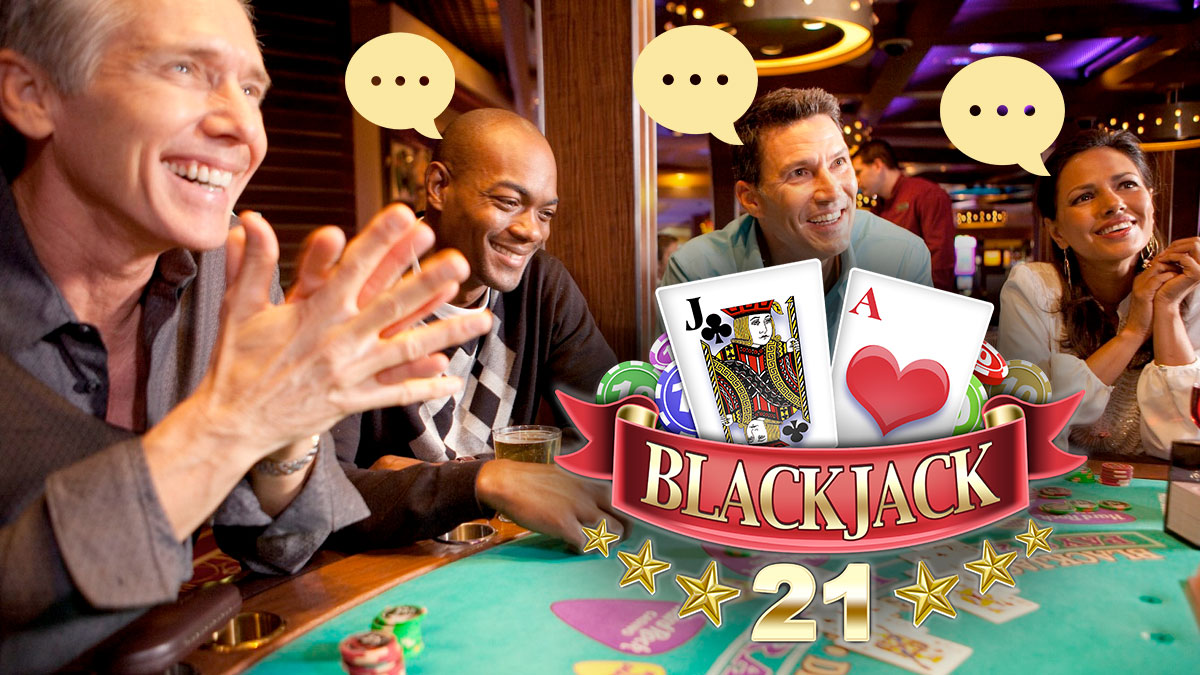One of the first things about gambling games that new players discover is how important it can be to learn the proper lingo. The casino community is fairly insulated, creating a culture defined by insider knowledge and a sense of tradition.
Until you can catch up on the slang terms and other linguistic quirks employed by gamblers and dealers alike, you’ll tend to feel like an outsider looking in.
If you enjoy real money blackjack, you should know what doubling down entails, the difference between a hard and soft 16, and when splitting a pair is the best play. But even experienced blackjack enthusiasts out there could use a lesson on the seven blackjack slang words explained below.
1 – Shoe
The term “shoe” refers to the elongated hard plastic case which stores the six or eight decks used in most modern blackjack games.
Shoes are a relatively recent addition to blackjack gameplay, only coming to prominence in the 1960s after early card counting techniques rendered single-deck tables unfeasible for the house. Once casino managers realized that more decks in play could counteract a card counter’s attempts to gain an edge, blackjack shoes became ubiquitous throughout Sin City and beyond.
Asking a dealer to wield a stack of eight decks containing over 400 cards would be impractical, shoes are a godsend for both the house and players alike.
From the player’s perspective, the shoe ensures that a steady stream of cards can be delivered without delay. And if you’re running a casino, effectively eliminating the scourge of card counters—and the rare statistical advantage they earn over the house—makes the shoe a legitimate miracle.
2 – Up Card
The last card to come out of the shoe on any given hand goes face up to the dealer, thus, it has come to be known as the dealer’s “up card.”
Representing one half of the dealer’s two-card starting hand, the up card provides blackjack players with a precious bit of partial information while gambling in a casino. By comparing the relative strength or weakness of that up card to the player’s two-card starting total, blackjack’s first basic strategy charts were born.
Obviously, players like to see the dealer’s up card rank as low as it can go for a number of reasons. First off, when the dealer shows a lowly 2 or 3 for their up card, combining that with a likely 10 down card gives them an untenable 12 or 13 total. Any big card they draw from there will send them straight to bust town, meaning any player with a live hand wins their wager.
Conversely, when the dealer shows a strong up card like a 10-value, 9, or even an ace, players know they must act boldly and hit their way to a superior total.
Knowing how the dealer’s up card influences your own odds of winning the hand is part and parcel with blackjack success. To wit, just check out the table below to see how various up cards change the dealer’s chances of going bust.
| Dealer Up Card | Likelihood of Going Bust |
|---|---|
| 2 | 35.50% |
| 3 | 37.41% |
| 4 | 39.58% |
| 5 | 41.84% |
| 6 | 42.28% |
| 7 | 26.19% |
| 8 | 24.36% |
| 9 | 23.12% |
| 10 | 22.89% |
| Ace | 16.70% |
As you can see, the ace is obviously the dealer’s best friend when it comes to up cards, giving them a scant 16.70% shot to go bust.
But the worst cards for dealers to show—and the prettiest sights for a player to look down at—is when the up card is a 5 or 6. In those cases, the dealer will go bust over 40% of the time.
3 – Stiff
Holding cards like the 2, 3, 4, 5, and 6 clearly make things difficult for the dealer, and the same is true for players as well. For that reason, those low-value cards are collectively known as “stiffs” amongst blackjack aficionados.
Along the same lines, when you hold any two cards which create a total of 12, 13, 14, 15, or 16, you’re stuck with a stiff hand.
Trying to navigate a stiff hand successfully is rough going, because standing on these middling totals will leave you vulnerable to most of the dealer’s final totals. Nonetheless, hitting on a stiff hand like 16 only gives you a few low cards in the shoe to work with, as anything over a 5 will leave you busted.
One easy way to remember the stiff hands is that hitting and drawing any 10-value card will immediately make you go bust.
As for the basic strategy charts, they actually present a rather elegant solution to “solving” these stiff hands. Here’s how it works.
When you start with any stiff 13, 14, 15, or 16, you should always stand against any stiff dealer up card (2, 3, 4, 5, or 6). Should the dealer show a strong up card of 7-ace, you should suck it up and hit in hopes of improving your stiff hand.
As for the stiff 12s in the deck, the rules remain largely the same other than hitting on 12 against a dealer’s 2 or 3 up card.
4 – Third Base (Anchorman)
If you envision the blackjack table from the dealer’s point of view, and each seat as a base on the baseball field, you should soon see where this slang term originated.
The “third base” seat is the last seat on the dealer’s revolution around the table, or the one closest to their right arm. Anyone seated in the third base position will be the last player to act on each hand, otherwise known as the “anchorman” or “the anchor.”
Regular blackjack players can be a finicky bunch when it comes to the third base seat, based mostly on their mistaken belief that the last player to act helps determine the dealer’s outcome.
Picture the following hand going down to get my drift.
You’re betting $50 a hand and peek down to see a sweet pair of queens starting back at you. This makes your starting total of 20 a keeper against the dealer’s stiff 6 up card. After you stand, two other players hit and go bust. The spotlight then falls on a tourist in the third base seat betting one measly $5 chip at a time.
This player clearly isn’t well-versed in basic blackjack strategy, and they spend more time chatting up the cute dealer than actually playing their cards. Realizing the action is now on them, they look down at their 12 and casually utter, “Hit me, I guess.”
Like clockwork, the dealer slides the tourist a 10 and they go bust in astonishment. Next up, the dealer shows their expected face card underneath for a 16 total, and with a flourish, draws a perfect 5 to make 21.
As the dealer drags your big bet into her drawer, you can’t help yourself from informing the tourist about their awful play:
“Hey guy, don’t do the dealer any favors here. You just took her bust card!
That 10 was hers if you just play by the book and stand with 12 against a 6 there.
Now, I lose a couple quarters on a 20 because you don’t know how to play third base? Screw that, find an easier seat to play, kid.”
Tense situations like this crop up after third base mistakes on every blackjack table in the world. For that reason, regulars advise rookies to steer clear of third base until they master basic strategy.
Of course, these strategy “experts” have also fallen for a common gambler’s fallacy. Even though that isolated hand did hinge on the third base player’s decision, an extended sample size over a longer session will tend to balance things out. In other words, for every third base decision that benefits the dealer, you’ll see another that takes their gin card and replaces it with a bust instead.
5 – Five-Card Charlie
Speaking of stats, once in every 50 hands or so, the deck will deliver a rarity known as the “Five-Card Charlie.”
This hand consists of any five cards that total 21 exactly without going over. You might see the 2-3-4-5-7, or maybe the ace-3-4-5-8, but they’re both Five-Card Charlies.
A few casinos back in the day used to pay out a premium 2:1 payout if you landed a Five-Card Charlie, but those tables are long gone in 2021.
6 – Snapper
Another term for a “natural” or “blackjack,” the snapper is the any ace + any 10-value card that gives the game its name.
The word originated from the slapping sound made when dealers would top off a $5 payout with an extra $2.50 chip on blackjack at 3:2 odds. In fact, those typically pink $2.50 chips are widely known as slappers in many regional American gambling hotspots.
7 – Heads Up (Heads On)
Ported over from the poker world, a “heads up” or “heads on” game is one which involves the dealer and a lone player.
Usually competing for high stakes, heads up specialists prefer the privacy of an empty table, both so they can focus and to avoid any third base snafus. When you see somebody playing heads up for big bets, it’s considered proper casino etiquette to wait until a new shoe and ask if you can join the game.
Conclusion
Part of the fun associated with casino gambling is the way it creates little subcultures all its own. Table game players have their parlance, while machine game players talk a different language all their own.
As you can see, blackjack isn’t immune from this phenomenon by any means. Between stiff cards and snappers, Five-Card Charlies and third base, up cards and heads up play, blackjack tables are home to their own unique set of slang.
Michael Stevens
Michael Stevens has been researching and writing topics involving the gambling industry for well over a decade now and is considered an expert on all things casino and sports betting. Michael has been writing for GamblingSites.org since early 2016. …



